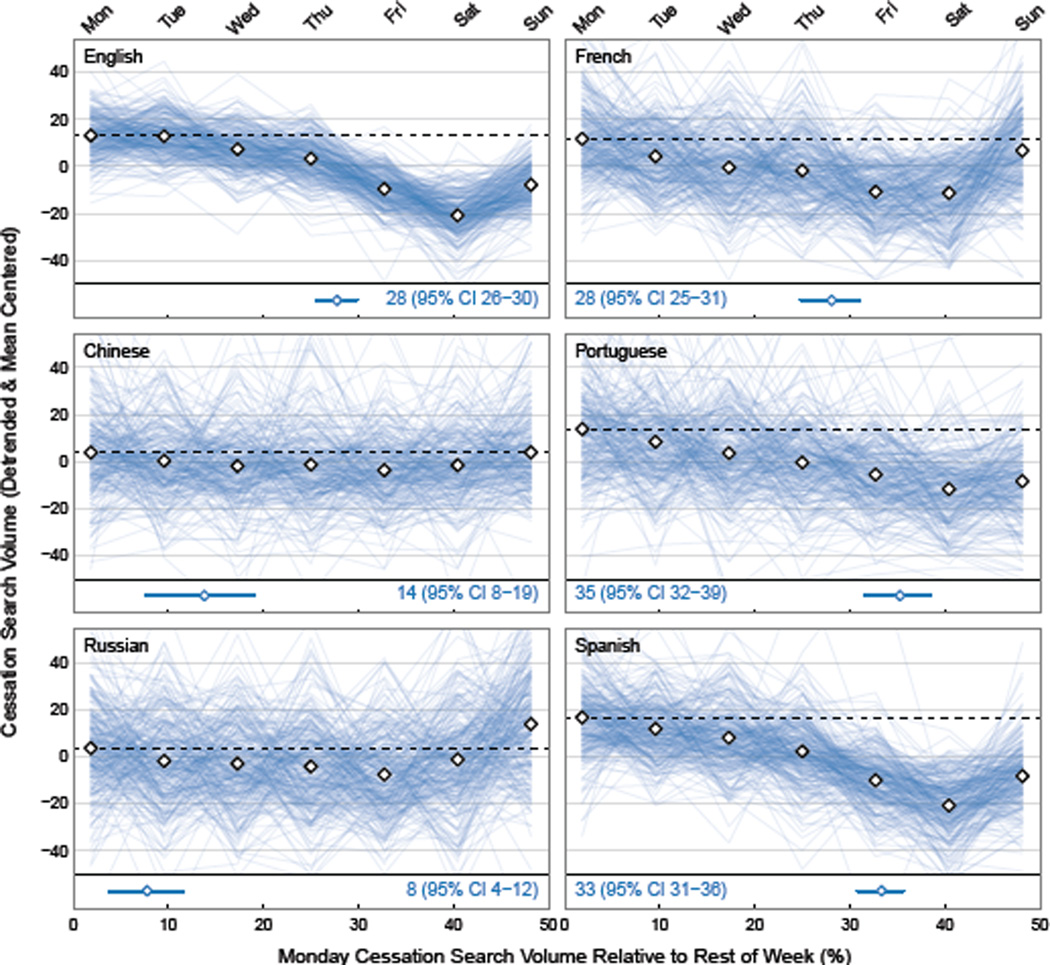Introduction
Smokers’ rhythms in contemplating quitting or making quit attempts are poorly understood. Tobacco control has focused on annual events (e.g., New Year’s Day), but weekly “circaseptan” time-cycles may likewise exist. For example, many illnesses (e.g., strokes) are more common on Mondays.1 Do cessation behaviors also have weekly rhythms?
Methods
Traditional survey-based assessments are inadequate to capture weekly cessation rhythms. However, examining how individuals search online takes surveying them to the next level by revealing both the searcher’s thoughts, through the types of queries undertaken, and their actions toward behavior change, through engaging in the search behavior itself.2
Global Google cessation query trends in English, French, Mandarin/Cantonese, Portuguese, Russian, and Spanish were monitored from January 2008 through 2012 (google.com/trends). In English, all queries including “quit” and “smoking” (e.g., “quit smoking help”) were combined into a single trend. This was repeated for “arrêter de fumer”, “戒烟”, “parar de fumar,” “бросить курить” and “dejar de fumar.” Because raw volumes are misleading (all searches may decline on Saturday), a normalized, daily ratio of cessation queries to all queries was analyzed (relative search volume [RSV]).
A continuous wavelet transform was used to isolate the weekly component of the time series.3 This is preferred over a regression because it is assumption free. The resulting series was intuitively compared as daily ratios (e.g., (Monday–Tuesday)/Tuesday) after adding the mean RSV because the wavelet is mean-centered. Confidence intervals (alpha=0.05) were simulated using bootstraps from the ratio’s sampling distribution.
Results
Weekly, cessation queries in English peaked early, declined thereafter, then rebounded on Sunday (Figure). The trend lines neatly overlapped, with the variance between weeks less than within weeks (intraclass correlation coefficient, 0.03 vs. 0.62). Patterns were similar across languages, with higher volume earlier in the week and mostly on Monday.
Figure 1. Daily Trends in Smoking Cessation Google Queries.
Note: Major panels show segments of the weekly trend line for 2008–2012 layered over one another with the mean for each day of the week highlighted by a diamond, as estimated from the wavelet-reconstructed time series. A reference line for the Monday mean was added to aid interpretation. Minor panels show Google search volume for Monday relative to the combines Tuesday through Thursday mean.
Monday query volumes were 25% (95%CI, 24–26%) higher than the combined Tuesday through Sunday mean for all languages. Cessation queries in English on Monday were 1% (95%CI, −1 to 3%) greater than on Tuesday, 11% (95%CI, 9–14%) greater than on Wednesday, 22% (95%CI, 19–26%) greater than on Thursday, 67% (95%CI, 62–73%) greater than on Friday, 145% (95%CI, 134–157%) greater than on Saturday, and 59% (95%CI, 54–64%) greater than on Sunday. For French, Portuguese and Spanish, queries were significantly higher on Monday than on other days. Mandarin and Russian queries were significantly higher on Monday, except Sunday. In total, of 36 comparisons, Monday volumes were significantly greater 33 times, indistinguishable twice and smaller once, an unlikely finding (p< .001e−5).
Raw search volumes were estimated by applying the mean global monthly volume for “quit smoking” and its next 100 related terms from Google Adwords (adwords.google.com) to our results. For this sample of Google queries in Enlgish, there were 153,800 more searches on Monday than the Tuesday through Sunday mean, totaling 8,000,000 each year.
Discussion
Just as illness has a weekly clock, so do cessation behaviors. The discovery of weekly rhythms in quitting contrasts with previous scientific understanding and can be harnessed to improve cessation advocacy.
Individual quitting behaviors have been described as “chaotic.”4 A birds-eye view of the population, however, suggests anything but chaos. Quitting behaviors are not spontaneous events but are instead an aggregate phenomenon partially governed by a weekly clock. To fully appreciate the micro-decision to quit, we must begin exploring macro-dynamics, such as interconnectedness,5 in lieu of individual psychology.
Given that most cessation contemplations do not result in successful quits, public health advocates can use these findings to facilitate quitting by providing resources (staffing smoking cessation lines) when more smokers are engaged in the quit process through day-of-the-week targeting. Hypothetically, 145% more susceptible English-speaking smokers may need resources on Monday than on Saturday.
Finally, developing research agendas and advocacy priorities around weekly rhythms in cessation is justified by our findings. Weekly clocks likely impact other behaviors, and ours are just initial steps toward a more substantial (and novel) research program to discover these patterns.
Acknowledgements
We thank Andy Keller MD and Rachel Althouse BS for help with translation. We thank Keith Schnakenberg PhD and Mauricio Santilliana PhD for advice on data modeling. This work was supported through a cooperative agreement between the Monday Campaigns and the Johns Hopkins Bloomberg School of Public Health. Dr. Ayers also acknowledges the support of the National Cancer Institute (RCA173299A). The funders had no role in the design and conduct of the study; in the collection, management, analysis, and interpretation of the data; or in the preparation, review, or approval of the manuscript.
References
- 1.Dunlap JC, Loros JJ, DeCoursey PJ, editors. Chronobiology : biological timekeeping. Sunderland, Mass.: Sinauer Associates; 2004. [Google Scholar]
- 2.Ayers JW, Althouse BM, Allem JP, Ford DE, Ribisl KM, Cohen JE. A novel evaluation of world no tobacco day in latin america. J Med Internet Res. 2012;14:e77. doi: 10.2196/jmir.2148. [DOI] [PMC free article] [PubMed] [Google Scholar]
- 3.Percival DB, Walden AT. Wavelet methods for time series analysis. Cambridge: Cambridge University Press; 2000. [Google Scholar]
- 4.Larabie LC. To what extent do smokers plan quit attempts? Tob Control. 2005;14:425–428. doi: 10.1136/tc.2005.013615. [DOI] [PMC free article] [PubMed] [Google Scholar]
- 5.Christakis NA, Fowler JH. The collective dynamics of smoking in a large social network. N Engl J Med. 2008;358:2249–2258. doi: 10.1056/NEJMsa0706154. [DOI] [PMC free article] [PubMed] [Google Scholar]



